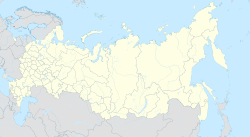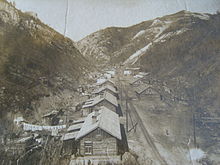world.wikisort.org - Russia
Dalnegorsk (Russian: Дальнего́рск, lit. far in the mountains) is a town in Primorsky Krai, Russia. Population: 37,519 (2010 Census);[2] 40,069 (2002 Census);[7] 49,792 (1989 Census).[8]
This article uses bare URLs, which are uninformative and vulnerable to link rot. (August 2022) |
Dalnegorsk
Дальнегорск | |
|---|---|
Town[1] | |
 Goreloye Microdistrict in Dalnegorsk | |
 Coat of arms | |
Location of Dalnegorsk  | |
 Dalnegorsk Location of Dalnegorsk  Dalnegorsk Dalnegorsk (Primorsky Krai) | |
| Coordinates: 44°33′N 135°35′E | |
| Country | Russia |
| Federal subject | Primorsky Krai[1] |
| Founded | 1897 |
| Town status since | August 31, 1989 |
| Government | |
| • Mayor | Igor Sakhuta |
| Elevation | 220 m (720 ft) |
| Population | |
| • Total | 37,519 |
| • Estimate (2018)[3] | 34,694 (−7.5%) |
Administrative status | |
| • Subordinated to | Dalnegorsk Town Under Krai Jurisdiction[1] |
| • Capital of | Dalnegorsk Town Under Krai Jurisdiction[1] |
Municipal status | |
| • Urban okrug | Dalnegorsky Urban Okrug[4] |
| • Capital of | Dalnegorsky Urban Okrug[4] |
| Time zone | UTC+10 (MSK+7 |
| Postal code(s)[6] | 692441–692443, 692446, 692448 |
| Dialing code(s) | +7 42373 |
| OKTMO ID | 05707000001 |
| Website | web |
Name
It was formerly known from its founding in 1897 as Tetyukhe (Russian: Те́тюхе; Chinese: 野豬河; pinyin: Yězhūhé; literally meaning "river of wild boars"), until it was renamed in 1973 as part of a campaign to change any Chinese-derived place names in Primorsky Krai.
History
The settlement of Tetyukhe was founded in 1897,[9] with the founding of a lead and zinc mine by Swiss immigrant Julius Brynner. Brynner's son Boris maintained the right to mine on the site until 1931, one of the longest-running private enterprises in the Soviet Union. Boris Brynner's son Yul Brynner later became a famous actor in the United States.[10]

In 1930, Tetyukhe was granted urban-type settlement status. The settlement was renamed in 1973, along with the Tetyukhe River which was renamed Rudnaya, from the Russian word "руда" meaning "ore". Town status was granted to Dalnegorsk on August 31, 1989.[11]
Administrative and municipal status
Within the framework of administrative divisions, it is, together with seven rural localities, incorporated as Dalnegorsk Town Under Krai Jurisdiction—an administrative unit with the status equal to that of the districts.[1] As a municipal division, Dalnegorsk Town Under Krai Jurisdiction is incorporated as Dalnegorsky Urban Okrug.[4]
Economy
Most population of the town is employed by two industrial enterprises: JSC Bor and JSC Dalpolimetal.
Established in 1965, Bor is the world's largest specialized chemical enterprise[citation needed]. Due to the unique deposits of commercial minerals found in the district, and the high technologies applied, Bor successfully operates in the world market and is included in the list of Russia's forty most prospective enterprises. Three-quarters of its production is exported to the United Kingdom, Italy, France, Japan, Australia, South Korea, China, and other countries in Europe and Asia.
Dalpolimetal, established in 1897, produces 58% of Russia's lead. Two-thirds of its production is exported to Japan, China, and South Korea.[citation needed]
Despite the highly developed industrialization of Dalnegorsk, over 90% of the territory under its jurisdiction is covered with Korean Pine and mixed broadleaf forests, both of which attract nature tourism enthusiasts. However, Dalnegorsk residents suffer from serious lead poisoning from an old lead smelter and the unsafe transport of lead concentrate from the local lead mining site. This led the Blacksmith Institute to declare Dalnegorsk and neighboring Rudnaya Pristan in the top ten of worst polluted places on earth.[12] However, according to Anatoly Lebedev, leader of the ecological NGO BROK, this inclusion is questionable.[13]
Transportation
Dalnegorsk is connected by road to Vladivostok (517 km). The nearest railway station (in Chuguyevka) is located 198 kilometers (123 mi) from Dalnegorsk. The nearest sea port is 35 kilometers (22 mi) from the town at Rudnaya Pristan.
Politics
On October 19, 2006, three days before the elections, Dmitry Fotyanov, the mayoral candidate from the United Russia party who came second in the initial round of elections,[14] was gunned down from fire of a Kalashnikov assault rifle fire.[15] The weapons were located by the police in a minivan that was blown up near the offices of the local newspaper soon after the murder.[16] The run-off election was called off as both remaining candidates agreed to stand down.[14] The United Russia party called Fotyanov's death a "political murder".
Alleged UFO incident

Mount Izvestkovaya, also known as Height 611, is located in Dalnegorsk. It is the place of the alleged Height 611 UFO incident of 1986.
See also
- Chertovy Vorota Cave
References
Notes
- Law #161-KZ
- Russian Federal State Statistics Service (2011). Всероссийская перепись населения 2010 года. Том 1 [2010 All-Russian Population Census, vol. 1]. Всероссийская перепись населения 2010 года [2010 All-Russia Population Census] (in Russian). Federal State Statistics Service.
- "26. Численность постоянного населения Российской Федерации по муниципальным образованиям на 1 января 2018 года". Federal State Statistics Service. Retrieved January 23, 2019.
- Law #164-KZ
- "Об исчислении времени". Официальный интернет-портал правовой информации (in Russian). June 3, 2011. Retrieved January 19, 2019.
- Почта России. Информационно-вычислительный центр ОАСУ РПО. (Russian Post). Поиск объектов почтовой связи (Postal Objects Search) (in Russian)
- Russian Federal State Statistics Service (May 21, 2004). Численность населения России, субъектов Российской Федерации в составе федеральных округов, районов, городских поселений, сельских населённых пунктов – районных центров и сельских населённых пунктов с населением 3 тысячи и более человек [Population of Russia, Its Federal Districts, Federal Subjects, Districts, Urban Localities, Rural Localities—Administrative Centers, and Rural Localities with Population of Over 3,000] (XLS). Всероссийская перепись населения 2002 года [All-Russia Population Census of 2002] (in Russian).
- Всесоюзная перепись населения 1989 г. Численность наличного населения союзных и автономных республик, автономных областей и округов, краёв, областей, районов, городских поселений и сёл-райцентров [All Union Population Census of 1989: Present Population of Union and Autonomous Republics, Autonomous Oblasts and Okrugs, Krais, Oblasts, Districts, Urban Settlements, and Villages Serving as District Administrative Centers]. Всесоюзная перепись населения 1989 года [All-Union Population Census of 1989] (in Russian). Институт демографии Национального исследовательского университета: Высшая школа экономики [Institute of Demography at the National Research University: Higher School of Economics]. 1989 – via Demoscope Weekly.
- "История Дальнегорска (Тетюхе) » dalnegorsk.ru | Официальный сайт г.Дальнегорск (Тетюхе)".
- Mining history of the town Archived August 8, 2007, at the Wayback Machine on the website of Dalnegorsk (Russian)
- https://ru.wikisource.org/wiki/%D0%A3%D0%BA%D0%B0%D0%B7_%D0%9F%D1%80%D0%B5%D0%B7%D0%B8%D0%B4%D0%B8%D1%83%D0%BC%D0%B0_%D0%92%D0%A1_%D0%A0%D0%A1%D0%A4%D0%A1%D0%A0_%D0%BE%D1%82_22.09.1989_%E2%84%96_12666-XI
- "Website of Blacksmith Institute". Archived from the original on November 3, 2006. Retrieved October 19, 2006.
- Regnum New Agency. Ecologists of Primorye Territory (Russia) surprised at listing Rudnaya Pristan among the most polluted places in the world
- Mosnews.com News. Contender's Murder Leads to Canceled Elections in Russia's Far East[permanent dead link]
- ITAR-TASS. Mayoral candidate killed in Dalnegorsk Archived September 30, 2007, at the Wayback Machine
- BBC News. Election murder in Russian town
Sources
- Законодательное Собрание Приморского края. Закон №161-КЗ от 14 ноября 2001 г. «Об административно-территориальном устройстве Приморского края», в ред. Закона №673-КЗ от 6 октября 2015 г. «О внесении изменений в Закон Приморского края "Об административно-территориальном устройстве Приморского края"». Вступил в силу со дня официального опубликования. Опубликован: "Красное знамя Приморья", №69 (119), 29 ноября 2001 г. (Legislative Assembly of Primorsky Krai. Law #161-KZ of November 14, 2001 On the Administrative-Territorial Structure of Primorsky Krai, as amended by the Law #673-KZ of October 6, 2015 On Amending the Law of Primorsky Krai "On the Administrative-Territorial Structure of Primorsky Krai". Effective as of the official publication date.).
- Законодательное Собрание Приморского края. Закон №164-КЗ от 11 ноября 2004 г. «О Дальнегорском городском округе», в ред. Закона №243-КЗ от 6 мая 2005 г «О внесении изменения в статью 22 Закона Приморского края "О Дальнегорском городском округе"». Вступил в силу 1 января 2005 г.. Опубликован: "Ведомости Законодательного Собрания Приморского края", №73, 12 ноября 2004 г. (Legislative Assembly of Primorsky Krai. Law #164-KZ of November 11, 2004 On Dalnegorsky Urban Okrug, as amended by the Law #243-KZ of May 6, 2005 On Amending Article 22 of the Law of Primorsky Krai "On Dalnegorsky Urban Okrug". Effective as of January 1, 2005.).
External links
- Official website of Dalnegorsky Urban Okrug (in Russian)
- Dalnegorsk Business Directory (in Russian)
- Website of Dalnegorsk Central Town Library (in Russian)
- Giant Crystals of the Dalnegorsk mines
На других языках
[de] Dalnegorsk
Dalnegorsk (russisch Дальнего́рск) ist eine Stadt in der Region Primorje (Russland) mit 37.519 Einwohnern (Stand 14. Oktober 2010).[1]- [en] Dalnegorsk
[ru] Дальнегорск
Дальнего́рск — город в Приморском крае России. Административный центр Дальнегорского городского округа.Другой контент может иметь иную лицензию. Перед использованием материалов сайта WikiSort.org внимательно изучите правила лицензирования конкретных элементов наполнения сайта.
WikiSort.org - проект по пересортировке и дополнению контента Википедии